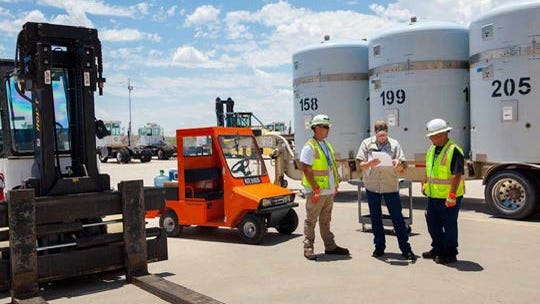Officials at the Waste Isolation Pilot Plant reported a “minimal” release of radioactive materials during a test of a ventilation fan and contended the fan could be used safely during maintenance operations at the nuclear waste repository near Carlsbad.
The fan was decommissioned after an accidental radiological release in 2014 led to contamination of parts of the underground where waste is disposed of, and a three-year halt of WIPP’s primary operations.
Restarting the fan was needed, officials said, to increase safety for workers by improving airflow to the underground.
More:DOE planning to increase down-blended plutonium shipments to Waste Isolation Pilot Plant
A four-hour test of the fan was conducted in January, and Sean Dunagan, president of Nuclear Waste Partnership – the primary operations contractor at WIPP – said the results showed any radiological risk from using the fan was negligible.
“Emissions were well below all regulatory limits,” Dunagan said. “At the WIPP site, we have two commodities: airflow and ground control. We want to make sure we have plenty of air in the underground.”
He said the increased airflow would also make it safer to use diesel equipment in the underground and reduce the risk from emissions and heat stress which can be high in certain areas.
More:‘Sparking’ nuclear waste drum at Los Alamos National Lab leads to evacuation at WIPP
“When we are at our current ventilation rates in the underground, there are parts in the underground that have less airflow than others,” Dunagan. “Those areas get very warm. By increasing ventilation, we reduce the risk of heat stress in those areas.”
The fan, known as the 700-C fan has a capacity of 240,000 cubic feet per minute (cfm), an increase of more than 90,000 cfm to the underground.
And because it vents directly into the environment, Dunagan said the fan would not be used during waste emplacement activities.
More:WIPP: Hearing planned for new utility shaft amid fears it could extend nuke waste disposal
Dunagan reported that the four-hour test was completed successfully, along with an analysis of the data gathered.
Next, the airflow will be balanced to verify the facility’s readiness for its use, and it will be restarted potentially in late July.
Through 114 samples from air monitors, Dunagan said there was no immediate elevation of contamination.
More:Staffing, scheduling problems imperil projects at Waste Isolation Pilot Plant, report says
Another more than 200 samples were collected by the Carlsbad Environmental Monitoring and Research Center (CEMRC) and showed similar results and were verified by the U.S. Department of Energy.
“What we learned from the four-hour test and those samples is that the 700-C fan can be operated safely,” Dunagan said. “That exposure to the public is well below allowable limits.”
Operating the fan would result in radiation exposure 5,000 times lower than the limit set by the U.S. Environmental Protection Agency, Dunagan said, less than the dose of radiation received from a smoke detector.
More:Nuclear waste project in southeast New Mexico delayed as feds demand answers
Ed Garza, assistance manager for the DOE’s Carlsbad Field Office said the fan will likely run for about two years as a rebuild of WIPP’s ventilation system known as the Safety Significant Confinement Ventilation System (SSCVS) is completed.
“There’s a variety of experts that continuously monitor hygiene at the site and ensure all the systems are working correctly. We’ve been very pleased with how things have proceeded,” he said. “Large pieces of equipment like that run better when they’re running, so to use them we have to do very expansive investigations.”
While various environmental and watchdog groups continued to express concern for the safety and necessity of the fan’s use, the project to restart it saw support from local leaders in Carlsbad.
More:New Mexico files lawsuit to block Holtec nuclear waste facility, cites risk to oil and gas
Carlsbad Mayor Dale Janway and Rick Fuentes, president of the United Steelworkers union which represents WIPP workers both wrote letters to the DOE supporting the project from its outset.
“Carlsbad is the host community to WIPP, and we certainly believe that the viewpoints of the host community should be assigned the highest value,” Janway said. “Most especially, the views of the men and women working at WIPP who will be most directly impacted should be given top consideration.”

New Mexico State Rep. Cathrynn Brown (R-55), whose district covers Carlsbad, said she supported the fan restart as a measure to improve airflow and thus safety in the underground.
“The additional airflow in the WIPP underground that will be made possible by the use of the 700-C fan will contribute to worker health and safety,” Brown said. “I therefore support the use of this fan.”
Jack Volpato, who serves as vice chair of the Carlsbad Mayor’s Nuclear Task Force said the added air was necessary to allow mining and maintenance to occur in the underground alongside waste emplacement.
This was needed, he said, for WIPP to meet waste disposal deadlines for the State of New Mexico and other DOE sites around the country.
“It’s super important that we’re able to do ground control, mine maintenance and emplacement of waste in a timely manner,” Volpato said.
“Everyone is always looking at waste emplacement but the mining and maintenance is most important at this point as far as keeping ahead on the maintenance and to clear the panels to get ready for the waste.”
And Volpato said that after the series of tests, sampling and monitoring, he was confident the data was accurate and showed the fan would be safe to use as the SSCVS is finished.
“I always thought there might be a little bit of a risk in starting it back up. I’ve been really pleased that they’ve gone through such a meticulous procedure to get it started,” he said.
“This will be a great stop gap effort until the SSCVS is online.”
John Heaton of the Eddy-Lea Energy Alliance – a consortium between Eddy and Lea counties and the cities of Carlsbad and Hobbs that works on area nuclear issues – said the test results were conclusive that the fan was safe to use and would improve worker conditions in the underground.
“The results of the study were very, very low numbers. I think the net result of it, I think the public should know the atmospheric radon is significantly higher than what that release was. The conclusion is its very safe to turn that fan on,” Heaton said.
“When you think about the extraordinarily low level, that fact makes it reasonable to turn that fan on because of the health and safety considerations for the underground and the people that are working there. More air means more safety.”
Adrian Hedden can be reached at 575-618-7631, achedden@currentargus.com or @AdrianHedden on Twitter.







